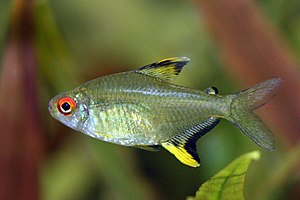Lemon tetra
| Lemon tetra | ||||||||||||
|---|---|---|---|---|---|---|---|---|---|---|---|---|

Lemon Tetra ( Hyphessobrycon pulchripinnis ) |
||||||||||||
| Systematics | ||||||||||||
|
||||||||||||
| Scientific name | ||||||||||||
| Hyphessobrycon pulchripinnis | ||||||||||||
| Ahl , 1937 |
The lemon tetra ( Hyphessobrycon pulchripinnis ), also called Schönflossensalmler ( Latin pulcher "beautiful, pretty", pinna "fin"), is a freshwater ornamental fish of the genus Hyphessobrycon . It becomes 5 cm long and can live to be 4 years old. On average, a specimen weighs 1.2 to 1.4 g.
features
The lemon tetra is brightly colored and got its name because of the lemon-colored spots. The body is high, flattened on the sides and slightly transparent.
Fin formula
ecology
Occurrence
The lemon tetra lives in rivers and streams that have black water in tropical South America . In Brazil , there in the Rio Tocantins . The waters in which the lemon tetra occurs have the following water values:
- a pH of 5.5 to 7.5
- a GH value of 2 ° d to 20 ° d
- a KH value of 2 ° to 10 °
- and a temperature of 23 ° C to 28 ° C.
Reproduction
In the wild, the animals perform their typical mating behavior after the rainy season. After the rainy season there are a lot of suspended matter and therefore prey in the water.
nutrition
The lemon tetra is omnivorous and feeds on algae, parts of plants, worms and crabs.
Aquaristics
The animals are schooling fish and should be kept in groups of at least ten animals if they are kept in an aquarium . Keeping them is quite simple. The lemon tetra is very peaceful. It is important not to socialize it with fish that are too large or even predatory fish, it can easily be socialized with shrimp. It can be kept in basins from 54 l. The water should be similar to black water so that the animals can develop properly and show their splendor of colors. Like many tetras , the animals protect themselves by forming a close swarm when danger threatens.
breed
It is a difficult species to breed. Readiness for spawning is initiated by simulating a rainy season (strong, abrupt partial water changes). A female lays around 300 eggs one after the other, which are spawned on the spawning substrate provided and fertilized by the males. The females are distinguished from the slimmer males by their fullness. The eggs should be separated from the adults after a short time. The larvae are very small and almost transparent. When the yolk sac is used up, the larvae can Artemia - nauplii are fed. The finest flake food can be given later.
Lining
The following food is also suitable in the aquarium: live food (Artemia, mosquito larvae , Grindal worms ), frozen food ( Cyclops ) and dry food ( food flakes, granules).
Individual evidence
- ↑ Günther Sterba: Freshwater fish of the world. 2nd Edition. Urania, Leipzig / Jena / Berlin 1990, ISBN 3-332-00109-4 .
literature
- Günther Sterba : The world's freshwater fish. 2nd Edition. Urania, Leipzig / Jena / Berlin 1990, ISBN 3-332-00109-4 .
Web links
- Lemon tetra on Fishbase.org (English)
- aqua4you
- IT IS
- Ornamental fish directory
- Lemon tetra on www.Aquarium-Guide.de
- Hyphessobrycon pulchripinnis inthe IUCN Red List of Threatened Species 2013.2. Posted by: Reis, R & Lima, F., 2007. Retrieved January 9, 2014.